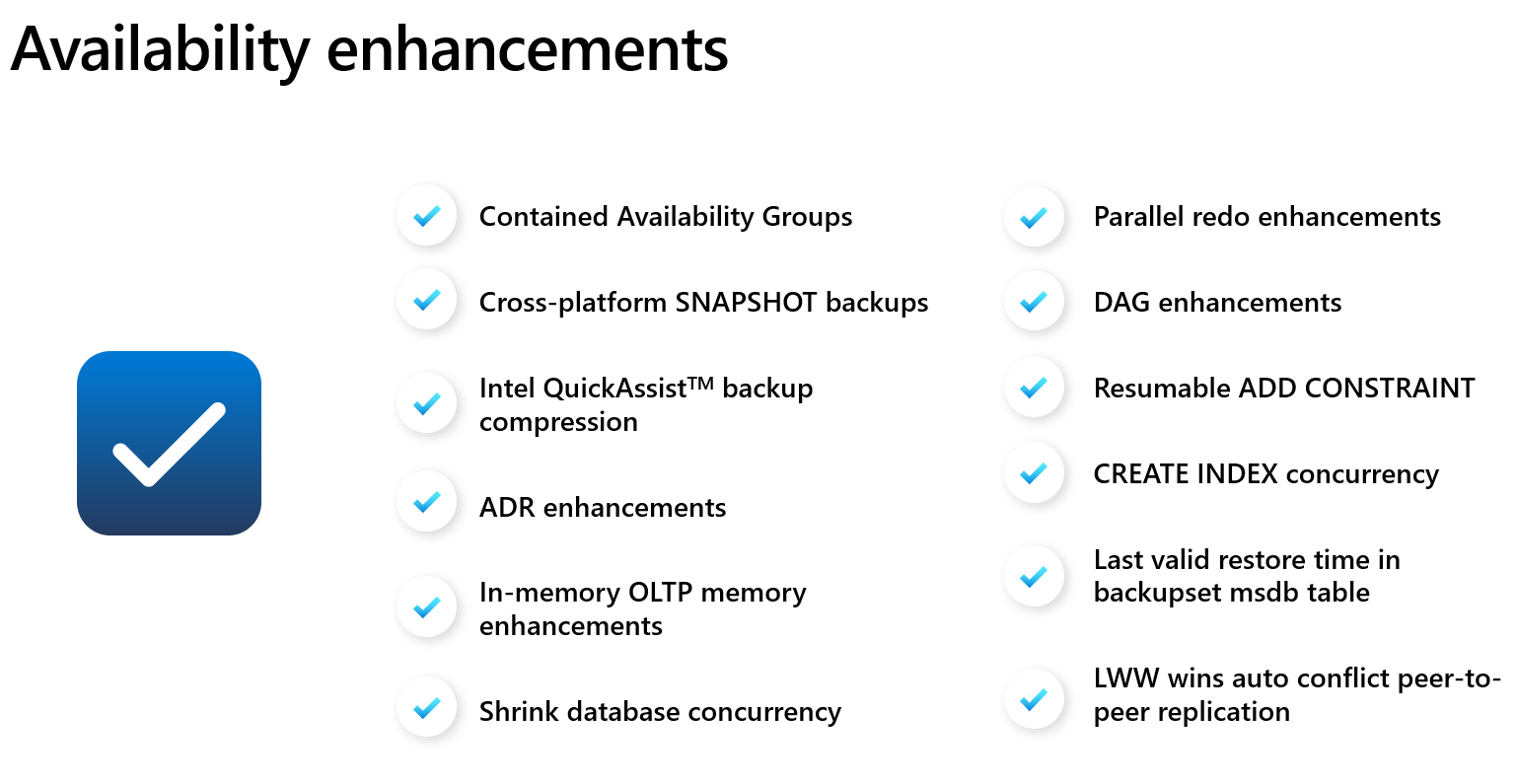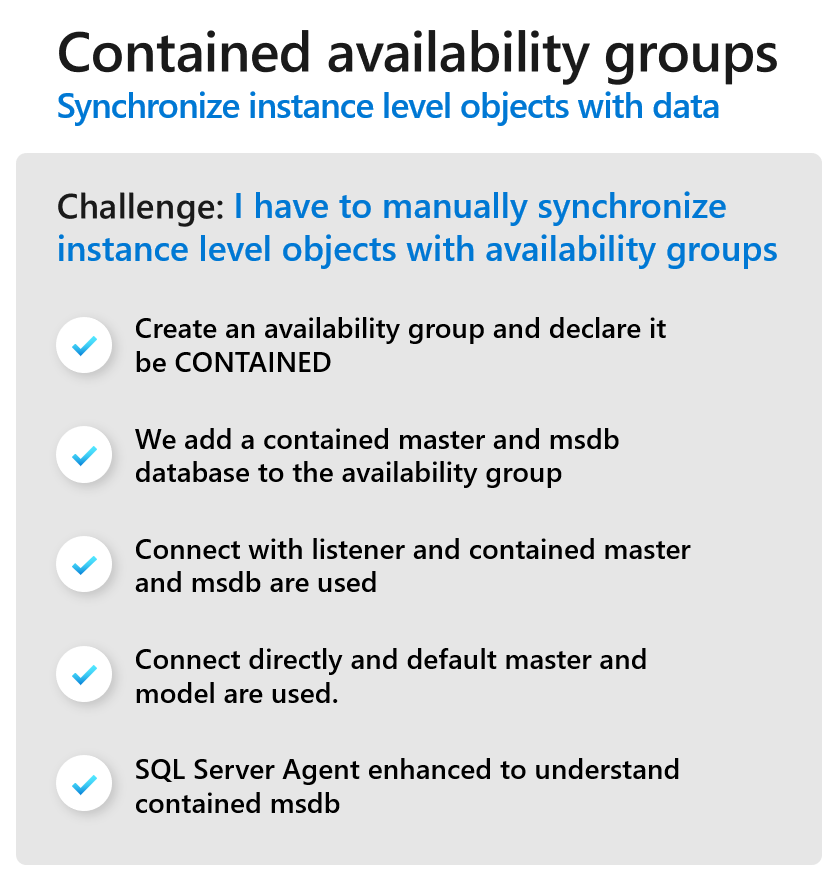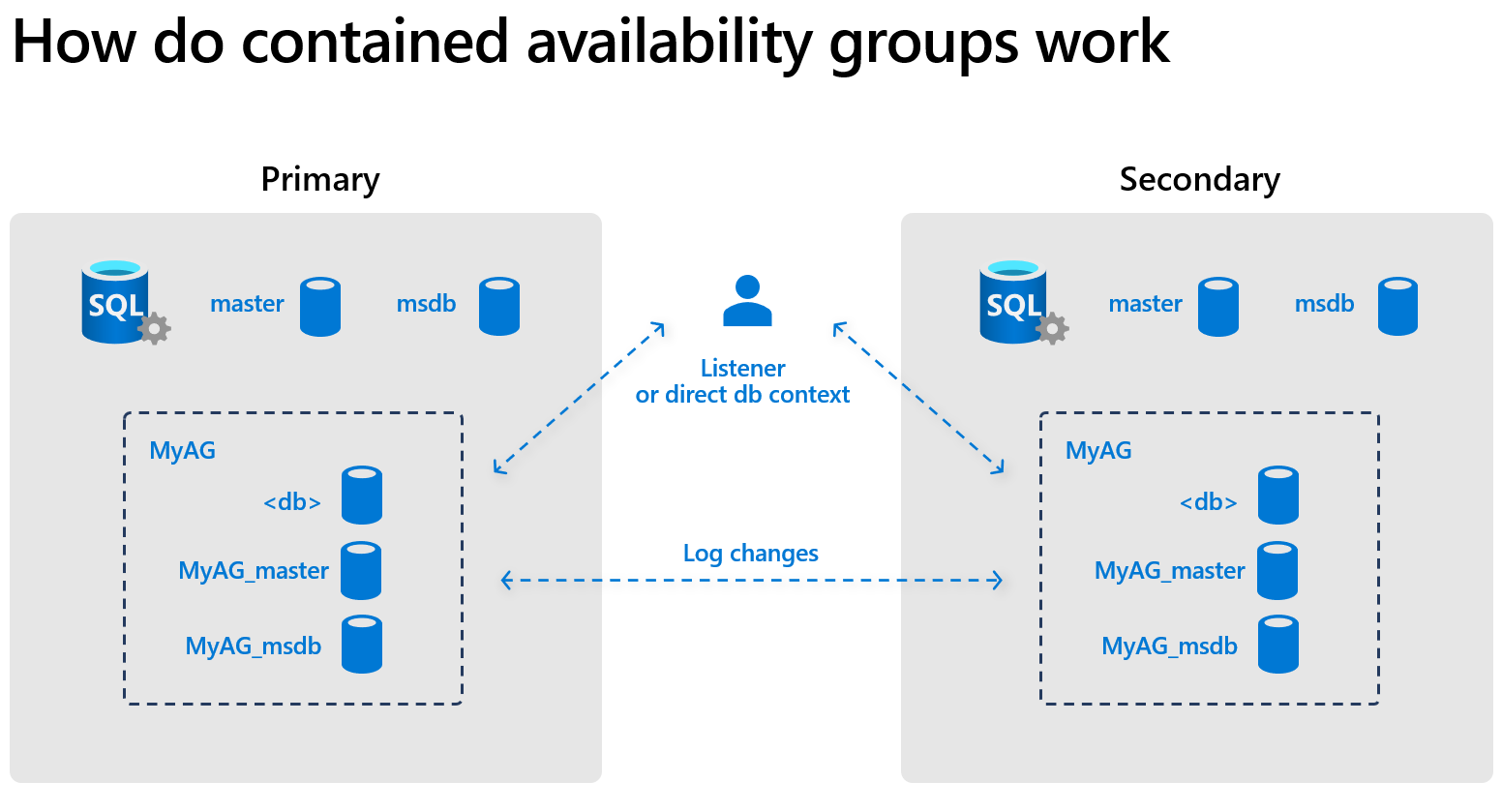Availability enhancements in SQL Server 2022
There are many availability enhancements to SQL Server 2022, but in this unit, we go over three of the major enhancements:
- Contained availability groups
- Cross-platform snapshot backups
- Intel® QuickAssist backup compression
For a list of other availability enhancements, see the following diagram and What's new in SQL Server 2022.

Contained availability groups
With the introduction of contained availability groups in SQL Server 2022, instance level objects are now replicated in a contained system database in the availability group along with the user databases. This allows you to failover the entire instance, including the system databases, to another instance in the availability group. This is a significant improvement over previous versions of SQL Server, where you could only failover user databases.
A contained availability group is an Always On availability group that supports:
- Managing metadata objects (users, logins, permissions, SQL Agent jobs, etc.) at the availability group level in addition to the instance level.
- Specialized contained system databases within the availability group.
Challenges with previous versions of SQL Server
Always On availability groups generally consist of one or more user databases intended to operate as a coordinated group, and those databases are replicated to one or more secondary replicas. In previous versions of SQL Server, objects such as users, logins, permissions, and SQL Agent Jobs, which are stored in one of the system databases (master or msdb) weren't replicated to the secondary replicas. This meant that if you had to failover to a secondary replica, you would have to manually recreate the logins, users, and SQL Agent jobs on the secondary replica. For applications or users that connect to an Always On availability group database, the database administrator (DBA) must ensure that any changes to those objects are duplicated across all replicas. This was a manual process that could be time consuming and error prone.
Contained availability groups solve the challenges by extending the concept of the group of databases being replicated to include relevant portions of the master and msdb databases. Contained availability groups are different from contained databases. Contained databases use a different mechanism for the user accounts, storing the user information within the database itself. Contained databases only replicate logins and users, and the scope of the replicated login or user is limited to that single database (and its replicas).
In contrast, in a contained availability group, you can create users, logins, and permissions at the availability group level, and they'll automatically be consistent across replicas in the availability group, as well as consistent across databases within that contained availability group. This saves the DBA from having to manually make these changes themselves.

How does a contained availability group work?
Each contained availability group has its own master and msdb system databases, named after the name of the availability group. For example, in contained availability group MyAG, you'll have databases named MyAG_master and MyAG_msdb. These system databases are automatically seeded to new replicas and updates are replicated to these databases just like any other database in an availability group. This means that when you add an object such as a login, or SQL Agent Job while connected to the contained availability group, you're able to authenticate using the login created in the contained availability group, and see the SQL Agent Job when the contained availability group fails over to another instance.

To be able to effectively utilize the features of a contained availability group, you must create a listener for the contained availability group. The listener is used to connect to the contained availability group, and is the only way to access the environment of the contained availability group. If you were to connect to one of the instances hosting the contained availability group rather than directly to the contained availability group through the listener, you would be in the environment of the instance, and not the contained availability group. This means that if you create a login or SQL Agent Job while connected to the instance, it wouldn't be replicated to the other replicas in the contained availability group.
Cross-platform snapshot backups
Snapshot backups provide a quick method to back up large SQL Server databases by avoiding the need to stream SQL Server files into backup file(s). Snapshots have been supported for SQL Server in previous versions, but has required a program that uses the Virtual Device Interface (VDI). This option allows you to take a snapshot backup of a database without the need to use VDI. Windows and SQL Server have provided methods to support snapshot backups using the Volume Snapshot Service (VSS) and the SQL Writer service (which uses VDI).
SQL Server 2022 provides built-in support for snapshot backups without VDI using the ALTER DATABASE T-SQL statement option SUSPEND_FOR_SNAPSHOT_BACKUP. When this statement is executed, SQL Server suspends all input/output (I/O) on database and transaction log files. Users can then use storage provider snapshot technologies to create a consistent snapshot backup from the underlying SQL Server database and transaction log files. The backup process is completed by backing up small amounts of metadata information into a file. This allows I/O to now continue for database and transaction log files.
Snapshot backups can be restored with the T-SQL RESTORE statement specifying the metadata backup file and all database and transaction log files from the snapshot backup.
This new method now allows snapshot backups to be performed across both Windows and Linux operating systems without relying on VSS, SQL Writer, or custom VDI applications.
For more information, see Create a Transact-SQL snapshot backup.
Intel® QuickAssist backup compression
SQL Server supports options to compress a backup, which can save large amounts of space for the target backup file. The process of compression can take a significant number of CPU cycles for threads within SQL Server that are compressing the backup file.
SQL Server 2022 can use a new compression technique powered by Intel® QuickAssist Technology (QAT). When a backup is executed using Intel® QuickAssist compression, the processing for compression is offloaded to the Intel® QuickAssist hardware versus the CPUs in the system. This provides more CPU cycles for queries and applications while the backup is being compressed.
For more information, see Integrated acceleration and offloading.